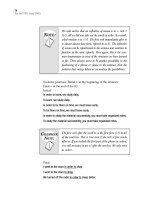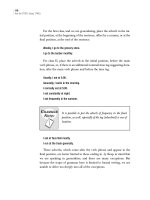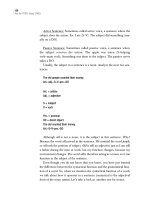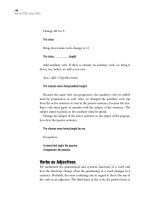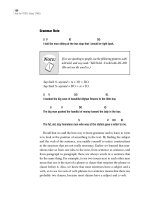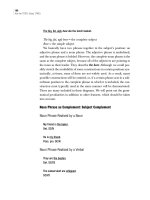Ace the toefl essay part 15
Bạn đang xem bản rút gọn của tài liệu. Xem và tải ngay bản đầy đủ của tài liệu tại đây (144.21 KB, 10 trang )
130
Ace the TOEFL Essay (TWE)
Active Sentence: Sometimes called active voice, a sentence where the
subject does the action. Ex: I ate (S–V). The subject did something (usu-
ally on a DO).
P
assive Sentence: Sometimes called passive voice, a sentence where
the subject receives the action. The apple was eaten (S–helping
verb–main verb). Something was done to the subject. The passive never
takes a DO.
Usually, the subject in a sentence is a noun. Analyze the next two sen-
tences.
The old people counted their money.
Art.–adj.–S–V–pro.–DO
Art. = article
Adj. = adjective
S = subject
V = verb
Pro. = pronoun
DO = direct object
The old counted their money.
Art.–S–V–pro.–DO
Although old is not a noun, it is the subject in this sentence. Why?
Because the word
old moved in the sentence. We omitted the word people,
so
old took the position of subject. Old is still an adjective, just as I am still
a father during the time at work, but my function changes, because my
environment changes. The word
old is therefore acting as a noun, so it can
function as the subject of the sentence.
Even though you do not know that you know, you have just learned
the difference between the syntactical function and the grammatical func-
tion of a word. So, when we mention the syntactical function of a word,
we talk about how it operates in a sentence (syntactical is the adjectival
form of the noun
syntax). Let’s take a look at another one for nouns.
TOEFL Internals flowed 7/13/07 3:36 PM Page 130
131
Syntax and Grammar
I see the good, the bad, and the ugly.
S–V–DO–DO–DO
DO = Direct object. In an active sentence, if the subject does something
to something else or someone, the thing or person receiving that action is
the DO. The verb must be active, however (not a
be verb). In this sentence,
the action verb is
see, so we must ask what is seen. The answer is the good,
the bad, and the ugly.
These words are adjectives like the word old. However,
they are acting like nouns in this sentence, so they are the DOs.
Look again at this sentence: The old counted their money.
The word
money is a noun, and it is the DO of the sentence. Its gram-
matical function is noun, and its syntactic function is DO. The structure is
the same as in the sentence we just looked at, except the words
the good,
the bad, and the ugly
function as the DOs even though they are all adjec-
tives. They do this by acting like nouns in accordance with where they are
located in the sentence.
It takes a little while to begin to recognize the similarity of certain
grammatical and syntactical structures in sentences. You can do it. If you
have problems, stop. Try to find the subject and the verb; after you do
that, you have won half of the battle. Most importantly, take your time.
You are not in a race. Relax.
Components of Sentences
Phrases: A phrase is one or more words with a specific duty in a sentence.
The noun in the following sentence is a noun phrase.
The dog ate.
The phrase can be a group of words with one specific duty. The follow-
ing verbs constitute a verb phrase.
I had been walking for quite some time.
These words, all of them, act as one unit in the sentence, called a syn-
tactic unit.
Had been walking is, of course, three words, but they must work
TOEFL Internals flowed 7/13/07 3:36 PM Page 131
132
Ace the TOEFL Essay (TWE)
together to fulfill the duty of telling a specific time. It is common for dif-
ferent parts of speech to work together as one unit to fulfill a specific duty
or function in the sentence. In that case, one word is the leader, called the
headword, and it determines the duty of the whole unit, much like a squad
leader in the army.
The big, fat, stupid camel walked across the road.
(The) big, fat, and stupid are adjectives. (An article, called a determiner,
is considered a subcategory of adjective, or an adjectival.)
However,
camel is a noun. Because all of the adjectives describe the
noun, the entire phrase is a noun phrase, with the noun as the headword,
the leader of the group. The duty, or the syntactic function, of the unit is
to be the subject of the sentence. Let’s make a further distinction.
1.
Camel is the simple subject of the sentence.
2.
The, big, fat, stupid camel is the complete subject of the sentence,
called complete because the adjectives complete the entire thought con-
cerning the headword.
The same logic holds true with other syntactic units. Look at the DO
in this sentence.
I passed the huge, pretty, old truck.
Huge, pretty, and old are adjectives. However, truck is a noun; therefore,
this is a noun phrase, and the syntactic unit is the DO of the sentence. But
huge, pretty, old is an adjective phrase.
A pretty huge truck means a very big truck.
We need to approach the grammar exactly like we did the pods for our
papers. Think of your sentence in geographical terms. Your subject and
verb are always the starting point. Everything from there should include
THE
:
RE
N
OTE
:
TOEFL Internals flowed 7/13/07 3:36 PM Page 132
133
Syntax and Grammar
looking at what comes to the left of the subject and what comes to the
right of the verb. The subject and the verb are the basic units of construc-
tion of every sentence in English. When we have a clause without a verb,
we speak of it in terms of a verbless clause.
Clauses
As we said before, there are two main types of clauses: (1) independ-
ent
, consisting of a subject and a verb and able to stand alone as a gram-
matical entity;
(2) dependent, usually consisting of a subject and a verb
and unable to stand alone as a grammatical entity. A DC depends on an
IC to make sense; therefore it is called a dependent or subordinate clause.
A subordinate clause usually has a subordinator at the beginning of it,
thereby making an otherwise independent clause dependent.
I was a boy = IC
When
I was a boy = DC
(Sub.)
There are several basic constituents of sentences. These con-
stituents are units sometimes made of the phrases and clauses seen above.
1. Subject
2. Verb
3. Objects: Direct and Indirect
4. Complements: Subject and Object
I hit the ball.
S–V–DO
A DO only comes after an action verb, called a dynamic verb. The
action is transferred from the subject to the DO: in other words, the sub-
ject does the action (of the action verb) to the DO.
I kicked the door.
S–V–DO
TOEFL Internals flowed 7/13/07 3:36 PM Page 133
134
Ace the TOEFL Essay (TWE)
I ate the bread.
S–V–DO.
Indirect Object
I gave him the test.
S–V–IO–DO
I wrote her a letter.
S–V–IO–DO
Or
I gave the test to him.
S–V–DO–IO
I wrote a letter to her.
S–V–DO–IO
Rule: The thing the action is performed on or done to is the DO.
If I can put a preposition in front of the noun at the end, that noun is
most likely the IO, but we call it the object of the preposition, even
though the function is similar.
However, the IO can take a preposition in front of it only when the IO
is at the end of the sentence. Compare the IOs in the sentences to those
at the end of the sentences.
Tip:
Think logically. We said that the DO receives the action of the sen-
tence. Some people get confused. Look at this sentence.
I gave the man a letter. I gave a letter to the man.
What did I give? A letter. To whom? To the man.
Logically, the letter received the action of giving. The letter was what
was given, not the man. I didn’t pick up the man and give him away. I
picked up the letter and gave it away. Therefore, the letter receives the
action from the verb. I did the action (performed the action) on the let-
ter and did it to the letter. The man receives the thing itself, the noun
TOEFL Internals flowed 7/13/07 3:36 PM Page 134
